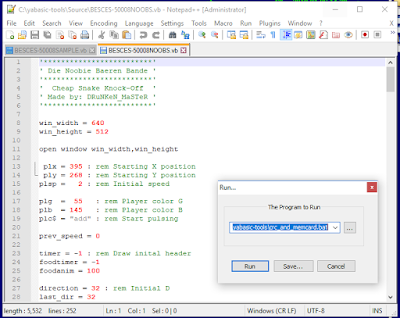Happy 2019 everbody!
This is a follow-up to my previous post: "Hacking" the PS2
This whole thing started basically when I discovered that there is a possibility to write your own programs for the PS2. I didn't have a PS2 back in the day (I started collecting consoles around 2011) so I just found out recently. Finding out how YaBasic worked and "reverse engineering" the checksum in the source code proved to be so entertaining that I basically lost interest in making a game after that.
During the holidays I had a lot of time and to make something productive I decided to take it up again and this time actually make a game. I also wanted to "streamline" the development process by not having to use 3 different programs and 2 OS's to test every change in the code I make.
My old process was:
- write the code in Vim
- run the Bash script (from the previous post) to add the checksum
- use PS2 Save Builder to make a save file
- use mymc to add the save file to the PCSX2 memory card file
Because PS2 Save Builder and mymc are both GUI programs that means a lot of clicking for a mistyped "endif" until I can test the change in PCSX2. So I ditched Linux (not having to switch back and forth from PuTTY), rewrote the Bash script in PowerShell (god, I fucking hate PowerShell, that language SUCKS), discovered that mymc has a CLI with a lot more functions than the GUI, added a Batch file for good measure and ... almost lost interest in making the game. Yeah, I drifted off again!
The new process isn't really shorter:
- write the code in Notepad++
- run the PowerShell script to add the checksum
- use mymc to add the source code to the PCSX2 memory card directly
But it's done a lot faster because of the extra batch file I added. That takes care of running PowerShell and mymc. And since I can execute any programs directly from Notepad++ (similar to Vim), I just need to press Ctrl+S and then F5 and hit Enter. Alt+Tab to PCSX2 and you are ready to load and run the code. ("F5" is the "Run" dialogue in Notepad++ and after selecting the script once I'll keep it as last option, so you don't have to select it every time.)
I've uploaded everything to Github if anybody is interested: yabasic-tools
I also would like to ditch Jacksum, because it needs Java and therefore it's a bit slow. If you know how to calculate CRC32_BZIP2 with Windows native tools (pure PowerShell/Batch only) let me know!
Where does all this take us? To making a game of course! See you in the next post (should be coming in a few days)!

Comments
Post a Comment